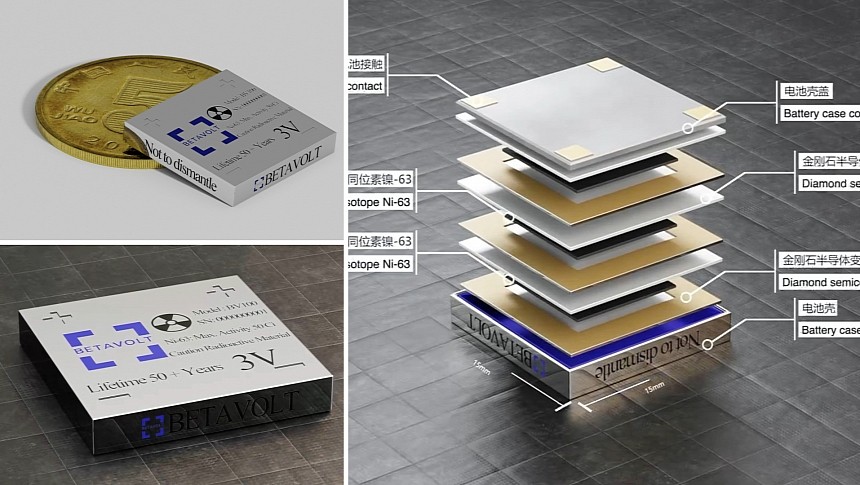Scientists are having a hard time pushing the boundaries of Li-ion batteries or other energy storage methods. Still, once in a while, an obscure company announces an unlikely breakthrough. Betavolt, a Chinese company that didn't even exist a couple of years ago, claims it developed an atomic energy battery that could generate electricity for 50 years without the need for charging or maintenance. Too good to be true?
While most of the research revolves around rechargeable batteries, some companies are still working on batteries that generate electricity instead of storing it from an outside source. Like alkaline batteries used in some toys and remotes, these don't need to be charged before use and can't be charged when they are depleted. At the end of their lifecycles, they are discarded, hopefully recycled. It's not very economical or even environmentally friendly, but rechargeable batteries don't make sense in all situations.
Betavolt claims it researched a non-rechargeable battery that can work for about 50 years, generating electricity constantly irrespective of outside conditions, including temperature and load. Unlike alkaline batteries, this uses atomic energy, which explains the long service period. The battery entered the pilot stage and is close to mass production. If successful, it would prove a boon for the aerospace industry, AI equipment, medical equipment, advanced sensors, small drones, and microrobots.
Betavolt's battery is what is called a radioisotope power source, converting the energy released by the decay of nuclear isotopes into electricity. To do that, it uses a semiconductor converter generating electric current from the transition of beta particles (electrons) emitted by the radioactive source nickel-63. Betavolt's innovation is precisely this semiconductor converter, which consists of a unique single-crystal diamond semiconductor that is just 10 microns thick. Betavolt placed a 2-micron-thick nickel-63 isotope sheet between two diamond semiconductor converters.
The first product that is now close to manufacturing is called BV100 and only delivers 100 microwatts of power at 3 volts. Sized at 15x15x5 millimeters (0.59x0.59x0.2 inches), it's smaller than a coin. The power is indeed very weak, but because electricity is generated continuously for 50 years, the energy density is huge. Betavolt claims the battery generates 8.64 joules per day and 3,153 joules per year.
Multiple such batteries can be used in series and parallel, depending on the application. The company plans to launch a 1-watt battery next year and improve on this value with future iterations. Such low figures don't give me high hopes about the possible use in electric vehicles. Still, the atomic battery might pave the way for mobile phones that don't need to be charged and drones that can fly continuously.
Betavolt claims its battery is safe, has no external radiation, and will not catch fire or explode in response to acupuncture and gunshots. It's also environmentally safe, being easy to recycle at the end of its life. After the decay period, the nickel-63 isotope turns into a stable isotope of copper, which is non-radioactive and does not pose any threat or pollution to the environment.
The company continues research on using various isotopes such as strontium-90, promethium-147, and deuterium to develop atomic energy batteries with higher power levels. Depending on the isotope, the service life could be shorter, between two and 30 years.
Betavolt claims it researched a non-rechargeable battery that can work for about 50 years, generating electricity constantly irrespective of outside conditions, including temperature and load. Unlike alkaline batteries, this uses atomic energy, which explains the long service period. The battery entered the pilot stage and is close to mass production. If successful, it would prove a boon for the aerospace industry, AI equipment, medical equipment, advanced sensors, small drones, and microrobots.
Betavolt's battery is what is called a radioisotope power source, converting the energy released by the decay of nuclear isotopes into electricity. To do that, it uses a semiconductor converter generating electric current from the transition of beta particles (electrons) emitted by the radioactive source nickel-63. Betavolt's innovation is precisely this semiconductor converter, which consists of a unique single-crystal diamond semiconductor that is just 10 microns thick. Betavolt placed a 2-micron-thick nickel-63 isotope sheet between two diamond semiconductor converters.
The first product that is now close to manufacturing is called BV100 and only delivers 100 microwatts of power at 3 volts. Sized at 15x15x5 millimeters (0.59x0.59x0.2 inches), it's smaller than a coin. The power is indeed very weak, but because electricity is generated continuously for 50 years, the energy density is huge. Betavolt claims the battery generates 8.64 joules per day and 3,153 joules per year.
Multiple such batteries can be used in series and parallel, depending on the application. The company plans to launch a 1-watt battery next year and improve on this value with future iterations. Such low figures don't give me high hopes about the possible use in electric vehicles. Still, the atomic battery might pave the way for mobile phones that don't need to be charged and drones that can fly continuously.
Betavolt claims its battery is safe, has no external radiation, and will not catch fire or explode in response to acupuncture and gunshots. It's also environmentally safe, being easy to recycle at the end of its life. After the decay period, the nickel-63 isotope turns into a stable isotope of copper, which is non-radioactive and does not pose any threat or pollution to the environment.
The company continues research on using various isotopes such as strontium-90, promethium-147, and deuterium to develop atomic energy batteries with higher power levels. Depending on the isotope, the service life could be shorter, between two and 30 years.






